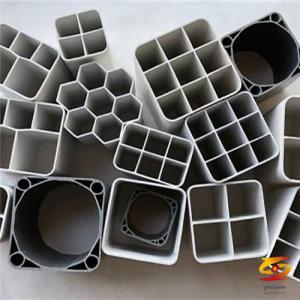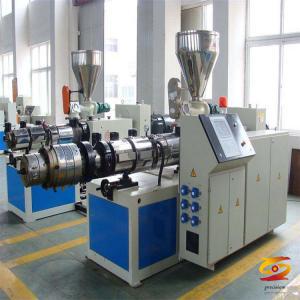PVC pipe production technology and process
PVC pipe production technology and processPVC plastic is a multi-component plastic. Different additives can be added according to different uses. Due to the different components, PVC products exhibit different physical and mechanical properties, which are used for different occasions. PVC plastic pipes account for a large proportion of plastic pipes. PVC water pipes are produced with a resin as the main material. The name of this resin is "pvc". Therefore, the name of the drain pipe is derived from the following Share PVC pipe production process and conditions.
There are two kinds of PVC pipes, hard and soft
RPVC pipe is made by mixing PVC resin with additives such as stabilizers and lubricants, and after pelletizing, it can be formed by extruder. It can also be formed by powder extrusion at one time. RPVC pipes have good chemical resistance and good insulation. They mainly transport various fluids and are used as wire bushings. RPVC pipe is easy to cut, weld, bond, and bend when heated, so it is very convenient to install and use.
SPVC pipe is made of PVC resin by adding a large amount of plasticizer and a certain amount of stabilizer, as well as other additives, after pelletizing and extrusion molding. SPVC pipe has excellent chemical stability, excellent electrical insulation and good flexibility and coloring. This kind of pipe is often used instead of rubber pipe to transport liquids and corrosive media. It is also used as cable sleeve and wire insulation Tube etc. In this article, we will talk in detail about the raw material selection, process flow, process control, and defects and improvement reasons of RPVC.
1. RPVC raw material selection and formula
In the production of hard tubes, the SG-5 resin with a low degree of polymerization should be selected. The higher the degree of polymerization, the better the physical and mechanical properties and heat resistance. However, the poor fluidity of the resin causes certain difficulties in processing, so the viscosity is generally selected. The SG-5 resin of (1.7 ~ 1.8) × 10-3Pa • s is suitable.
Hard tubes generally use lead-based stabilizers, which have good thermal stability and commonly use tribasic lead, but it has poor lubricity itself and is usually used in combination with lead and barium soaps with good lubricity.
For the processing of hard pipes, the selection and use of lubricants are very important. It is necessary to consider internal lubrication to reduce the intermolecular forces and reduce the viscosity of the melt to facilitate molding, as well as external lubrication to prevent the melt from sticking to the hot metal and make the product surface. bright.
Metal soaps are generally used for internal lubrication, and low melting waxes are used for external lubrication.
The filler mainly uses calcium carbonate and barium (barite powder). Calcium carbonate makes the surface performance of the pipe good. Barium can improve the moldability and make the pipe easy to shape. Both can reduce the cost, but too much amount will affect the performance of the pipe. And corrosion-resistant pipe is best to add no or less filler.
2. Process flow
The molding of RPVC pipe uses SG-5 type PVC resin, and adds stabilizers, lubricants, fillers, pigments, etc. These raw materials are kneaded according to the formula after proper treatment. If the pipe is extruded using a single screw extruder, The kneaded powder is pelletized and then extruded; if a twin-screw extruder is used, it can be directly formed with powder. The process flow of RPVC pipe is shown in Figure 3-1.
In addition, it can be different from the above-mentioned process in production, that is, powder is directly extruded without granulation, but two points should be noted:
1) First, it is best to use a twin-screw extruder for direct extrusion of powder. Because powder and pellets have one less mixing and shearing plasticizing process, the twin-screw extruder can strengthen the shear Plasticize to achieve the desired effect;
2) Secondly, because the granules are denser than the powders and have poor heat and heat conduction, the processing temperature of the powders may be about 10 ° C lower than the processing temperature of the corresponding granules.
3. Process conditions and control
In the production process, since PVC is a heat-sensitive material, even adding a heat stabilizer can only increase the decomposition temperature and prolong the stability time without decomposition. This requires that the molding temperature of PVC should be strictly controlled. Especially RPVC, because its processing temperature is very close to the decomposition temperature, often due to improper temperature control caused decomposition. Therefore, the extrusion temperature should be determined according to factors such as the formula, the characteristics of the extruder, the structure of the head, the screw speed, the position of the temperature measuring point, the error of the temperature measuring instrument and the depth of the temperature measuring point.
1. Temperature control
Temperature control is an important control factor in extrusion operations. The temperature control factors required for extrusion molding are barrel temperature, diameter temperature, and die temperature. The temperature is too low, the plasticization is poor, the appearance of the pipe is matt, the mechanical properties are poor, and the product quality does not meet the requirements: the temperature is too high, the material will decompose, and the product will become discolored.
2. Screw speed
The screw speed increases and the extrusion volume increases, which can increase the output, but it is easy to cause the phenomenon of poor plasticization, which causes the roughness of the inner wall of the pipe and the strength to decrease. At this time, the head pressure should be adjusted to achieve the best output and quality. The temperature control of the screw affects the material delivery rate, material plasticization, melting quality, etc. Extruded tubing needs cooling water to reduce the screw temperature, which is conducive to improving the quality of plasticization. The screw cooling water temperature is about 50 ~ 70.
3. Traction speed
The adjustment of the traction speed in the re-extrusion operation is very important. The material is melted and plasticized by extrusion, and is continuously extruded from the head and then pulled, so as to enter the shaping device, cooling device, traction device, etc. The traction speed should be comparable to the extrusion speed match. Generally, in normal production, the traction speed should be about 1% ~ 10% faster than the extrusion speed of the pipe.
4. Compressed air and pressure
Compressed air can inflate the pipe to keep the pipe round. The pressure should be appropriate. The pressure is too small, the pipe is not round, the pressure is too large, the core mold is cooled, the inner wall of the pipe is cracked, not smooth, and the quality of the pipe is reduced. At the same time, the pressure needs to be stable. If the pressure suddenly increases or decreases, the pipe is prone to slub status.
5. Temperature of sizing device and cooling device
Extruding different plastic products, using different sizing methods and cooling methods, the cooling medium can be air, water or other types of liquids, the temperature needs to be controlled, and its temperature is mainly related to production efficiency and product internal stress.
The above is to share with you the production process and conditions of pvc pipe, I hope the above introduction can help you。
If you want to know more about it please do not hesitate to
contact me. WhatsApp:+86-15966835076.









